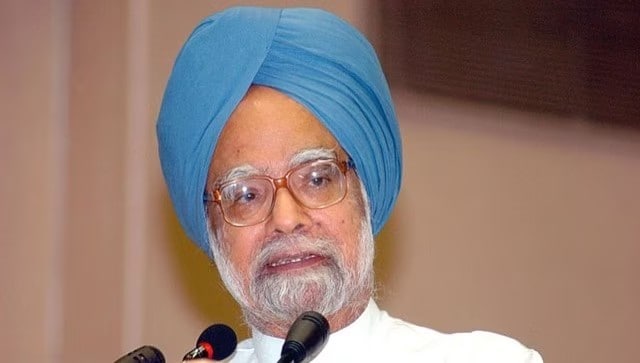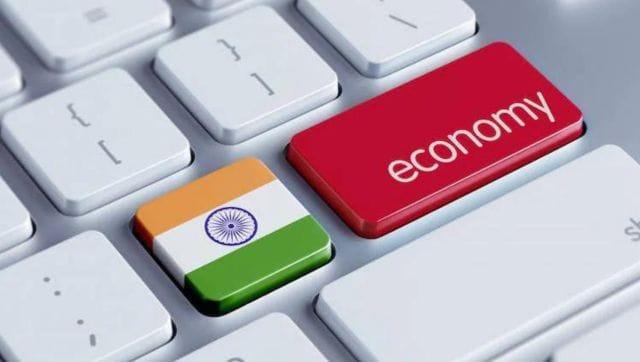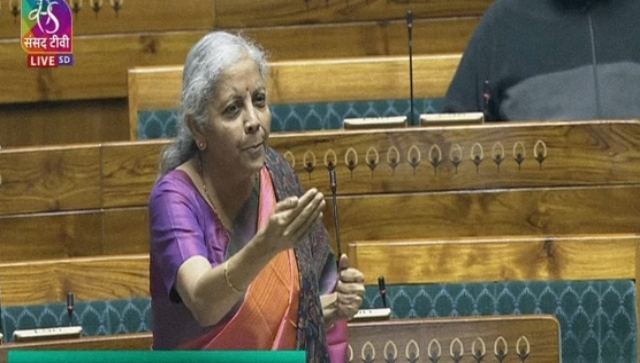A week after announcing the Interim Budget, finance minister Nirmala Sitharaman on Thursday tabled a White paper in Parliament. Sitharaman had in her Budget speech said the Centre would unveil a white paper on the economy highlighting a decade of economic mismanagement by the UPA. Sitharaman said the Centre has overcome the crisis of those years, and the economy has been put firmly on a high sustainable growth path with all-round development. The development comes just months before the 2024 Lok Sabha polls. But what are the key takeaways from the document? Let’s take a closer look: What did it say? The White paper tabled by the finance ministry said the economy was in poor shape when it came to power in 2014. “…the economy was in a fragile state; public finances were in bad shape; there was economic mismanagement and financial indiscipline, and there was widespread corruption,” the White paper stated.
“It was a crisis situation."
“The responsibility to mend the economy step by step and to put the governance systems in order was enormous,” it added. The White paper states that the government did not unveil a White paper back then as it did not want to shake the confidence of the public particularly investors. “The need of the hour was to give hope to the people, to attract investments, both domestic and global and to build support for the much-needed reforms. The government believed in ’nation-first’ and not in scoring political points,” the paper stated. The finance ministry in the paper said that now that the economy has been steadied and put on a path to recovery and growth, it is necessary to highlight the legacy of the UPA. “Every challenge of the pre-2014 era was overcome through our economic management and our governance. These have placed the country on a resolute path of sustained high growth. This has been possible through our right policies, true intentions, and appropriate decisions,” the paper said. ‘UPA made healthy economy non-performing’ The White paper said the UPA government inherited a healthy economy but made it non-performing in 10 years. “In 2004, when the UPA government began its term, the economy was growing at 8 per cent (with industry and services sector growth above 7 per cent each and a resuscitating agriculture sector growth above 9 per cent in FY04) amidst a benign world economic environment,” the White paper stated. It quoted the Economic Survey of 2003-04 as noting, “The economy appears to be in a resilient mode in terms of growth, inflation, and balance o payments, a combination that offers large scope for consolidation of the growth momentum with continued macroeconomic stability.” The paper said that though the UPA government often takes credit for the 1991 reforms, it discarded them soon after coming to power in 2004. [caption id=“attachment_12771822” align=“alignnone” width=“640”] File image of Manmohan Singh. Wikimedia Commons[/caption] “Even as the country was standing at the cusp of emerging as a powerful economy, little was done by the UPA government to build upon the strong foundation laid by the previous NDA government. In the years between 2004 and 2008, the economy grew fast, thanks to the lagged effects of the reforms of the NDA government and favourable global conditions. The UPA government took credit for the high growth but did little to consolidate it. The failure to take advantage of the years o high growth to strengthen the budget position of the government and invest in infrastructure to boost future growth prospects stood exposed.” It quoted a noted economist as saying, “The high growth and low inflation of the first five years were due mainly to the global economic boom of 2002-07 and the wide-ranging, productivity-enhancing economic reforms carried out prior to 2004. The UPA government’s economic policies were mediocre to start with and worsened increasingly as the decade evolved.” ‘Banking crisis an infamous legacy of UPA’ The White paper called the banking crisis ‘one of the most important and infamous legacies of the UPA.’ “When the Vajpayee-led NDA government took office, the Gross Non-Performing Assets (GNPA) ratio in Public Sector banks was 16.0 per cent, and when they left office, it was 7.8 per cent. In September 2013, this ratio, including restructured loans, had climbed to 12.3 per cent largely because of political interference by the UPA government in the commercial lending decisions of public sector banks,” the White paper said. “Worse, even that high percentage of bad debts was an underestimate.” The White paper noted that the 2014 banking crisis was ‘massive’ and the absolute sum at stake was too large. “Gross advances by public sector banks were only Rs 6.6 lakh crore in March 2004. In March 2012, it was Rs 39.0 lakh crore. Further, not all problem loans were recognised. There was much under the hood. According to a Credit Suisse report published in March 2014, the top 200 companies with an interest coverage ratio of less than one owed about Rs 8.6 lakh crore to banks. Nearly 44 per cent of those loans (`3.8 lakh crore) were yet to be recognised as problem assets. That alone would have added another 6.7 per cent to the GNPA ratio.” The White paper quoted ex-RBI governor Raghuram Rajan as saying in a written response to a Parliamentary Panel, “A larger number of the bad loans were originated in the period 2006-2008.” ‘Public finances in dire straits’ It also accused the UPA government of leaving public finances in dire straits.
File image of Manmohan Singh. Wikimedia Commons[/caption] “Even as the country was standing at the cusp of emerging as a powerful economy, little was done by the UPA government to build upon the strong foundation laid by the previous NDA government. In the years between 2004 and 2008, the economy grew fast, thanks to the lagged effects of the reforms of the NDA government and favourable global conditions. The UPA government took credit for the high growth but did little to consolidate it. The failure to take advantage of the years o high growth to strengthen the budget position of the government and invest in infrastructure to boost future growth prospects stood exposed.” It quoted a noted economist as saying, “The high growth and low inflation of the first five years were due mainly to the global economic boom of 2002-07 and the wide-ranging, productivity-enhancing economic reforms carried out prior to 2004. The UPA government’s economic policies were mediocre to start with and worsened increasingly as the decade evolved.” ‘Banking crisis an infamous legacy of UPA’ The White paper called the banking crisis ‘one of the most important and infamous legacies of the UPA.’ “When the Vajpayee-led NDA government took office, the Gross Non-Performing Assets (GNPA) ratio in Public Sector banks was 16.0 per cent, and when they left office, it was 7.8 per cent. In September 2013, this ratio, including restructured loans, had climbed to 12.3 per cent largely because of political interference by the UPA government in the commercial lending decisions of public sector banks,” the White paper said. “Worse, even that high percentage of bad debts was an underestimate.” The White paper noted that the 2014 banking crisis was ‘massive’ and the absolute sum at stake was too large. “Gross advances by public sector banks were only Rs 6.6 lakh crore in March 2004. In March 2012, it was Rs 39.0 lakh crore. Further, not all problem loans were recognised. There was much under the hood. According to a Credit Suisse report published in March 2014, the top 200 companies with an interest coverage ratio of less than one owed about Rs 8.6 lakh crore to banks. Nearly 44 per cent of those loans (`3.8 lakh crore) were yet to be recognised as problem assets. That alone would have added another 6.7 per cent to the GNPA ratio.” The White paper quoted ex-RBI governor Raghuram Rajan as saying in a written response to a Parliamentary Panel, “A larger number of the bad loans were originated in the period 2006-2008.” ‘Public finances in dire straits’ It also accused the UPA government of leaving public finances in dire straits.
It began by taking aim at the stimulus in response to the 2008 global financial crisis.
“The UPA Government’s response to the 2008 Global Financial Crisis – a fiscal stimulus package to combat the spill-over effects – was much worse than the problem it sought to address. It was way beyond the capacity of the Union Government to finance and sustain,” the White paper said. It noted that the stimulus did not correspond with the result it looked to achieve as the Indian economy was not severely hurt by the crisis. [caption id=“attachment_12881142” align=“alignnone” width=“640”] Representational image.[/caption] “During the GFC, India’s growth slowed to 3.1 per cent in FY09 but recovered swiftly to 7.9 per cent in FY10. A cross-country analysis using IMF data on real GDP growth during and after the GFC corroborates the fact that the impact on the Indian economy was relatively limited compared to other developed and developing economies,” the White paper said.
Representational image.[/caption] “During the GFC, India’s growth slowed to 3.1 per cent in FY09 but recovered swiftly to 7.9 per cent in FY10. A cross-country analysis using IMF data on real GDP growth during and after the GFC corroborates the fact that the impact on the Indian economy was relatively limited compared to other developed and developing economies,” the White paper said.
It argued that there was simply no need to continue stimulus after one year.
The White paper quoted the UPA government’s finance minister in a 2011 speech as saying, “India, unlike most other economies, was not seriously affected by the financial turmoil of 2008 in the developed world….” It also addressed the fiscal deficit during the UPA regime. “For six consecutive years between FY09 to FY14, the ratio of India’s Gross Fiscal Deficit (GFD) to Gross Domestic Product (GDP) was at least 4.5 per cent. It was between 4.5 per cent and 5 per cent of GDP in three out of the six years, between 5 per cent and 6 per cent in one, and more than 6 per cent in two years,” the White paper said. It noted that the revenue deficit increased over four times from 1.07 per cent of GDP in FY08 to 4.6 per cent in FY09. It rose again to 5.3 per cent in FY10, declined slightly to 3.3 per cent in FY11, and rose again to 4.5 per cent in FY12. “Run-away fiscal deficits led the economy to the fiscal precipice,” the White paper said. It quoted the Kelkar Committee for Fiscal Consolidation formed by the UPA government as saying during the 2012-13 financial year, “The Indian economy is presently poised on the edge of a fiscal precipice, making corrective measures aimed at speedy fiscal consolidation an imperative necessity if serious adverse consequences stemming from this situation are to be averted in an efficient and timely manner. A careful analysis of the trends in the current year, 2012-13, suggests a likely fiscal deficit of around 6.1 per cent, which is far higher than the budget estimate of 5.1 per cent of GDP, if immediate mid-year corrective actions are not taken. Runaway fiscal deficits, leading to unsustainable levels of public debt, can cause diverse forms of macroeconomic imbalances varying with the means through which the deficit is financed.” ‘UPA’s many scams’ It also took aim at the UPA government’s many scams. “The 2G spectrum scam involving 122 telecom licenses that had sliced Rs1.76 lakh crore off the exchequer as per the estimates of the Comptroller and Auditor General (CAG), the coal gate scam costing `1.86 lakh crore to the exchequer, the Common Wealth Games (CWG) scam, etc., indicated an environment of heightened political uncertainty and reflected poorly on India’s image as an investment destination,” the White paper said.
It noted that the 2014 coal scam ‘shook the conscience of the nation.’
It said that prior to 2014, coal blocks were allocated on an arbitrary basis without following a transparent process to allocate the blocks. “The coal sector was excluded from competition and transparency and the sector lacked investments and efficiencies. These actions were scrutinised by investigation agencies, and in 2014, the Hon’ble Supreme Court of India cancelled the allocation of 204 coal mines/blocks allocated since 1993,” it noted. The White paper also took aim at the 2G scam, which it says cost India’s telecom sector a ‘precious decade.’ “In the UPA regime, the process of allocation of spectrum lacked transparency and was frequently misused in the years leading up to 2008-09, which resulted in the “2G scam” and started the problems that finally caused a distress situation in the sector,” the White paper said. [caption id=“attachment_13616482” align=“alignnone” width=“640”] The White paper also took aim at the 2G scam, which it says cost India’s telecom sector a ‘precious decade.’[/caption] It noted that in for years after 2010, ‘virtually no or little spectrum could be allocated to the operators.’ This, it argued, halted the growth of the telecom industry. “The telecom licenses issued in FY09 were cancelled by the Hon’ble Supreme Court due to a lack of transparency in the allocation process. In this period, the telecom sector went into a seizure as the government was caught out by the Supreme Court judgement,” the White paper said. The White paper argued that this led to several issues including a number of operators becoming unviable, leaving this sector in a situation of limited competition. ‘UPA neglect of Aadhaar’ The White paper also that Aadhaar suffered under the UPA government. “Aadhaar, introduced by UPA in 2006, was the tangible development of the idea of a ‘multipurpose national card’ proposed by the Vajpayee-led NDA government, to be issued based on a National Register of Indian Citizens. The Registrar General of India initiated a National Population Register (NPR) programme while the former Planning Commission supervised the Unique Identity project,” the White paper noted. It said the UPA government could not forge a common purpose and noted ‘wide inter-ministerial differences in the scope, purpose and implementation responsibilities’. It said it was left to the NDA to revamp and reenergised Aadhaar as make it a ‘tool of empowerment that cuts away middlemen, helps facilitate direct subsidies to the poor deseeding duplicate beneficiaries, and brings authenticity to transactions.’ It said the story of Aadhaar under the UPA government was one of ineffective decision-making, little sense of purpose and policy failure. ‘From **f**ragile f****ive to t****op five in decade**’** The White paper noted that Morgan Stanley in 2013 had categorised India in the league of ‘Fragile Five’ –a group comprising emerging economies with weak macroeconomic fundamentals. “These, inter-alia, included low growth, high inflation, high external deficit and impaired state of public finances. The fact that the economy could only grow from being the 12th largest in 2004 to the 10th largest in 2014 merely exposed the short-lived, qualitatively inferior and unsustainable nature of the high growth experienced between 2005 and 2012,” the White paper noted. It said the UPA government left an ‘unenviable legacy of a structurally weaker economy and a pervasive atmosphere of despondency.’ The White paper said the Indian economy has witnessed many structural reforms that strengthened the macroeconomic fundamentals since the current government took power in 2014. “The government’s economic policy focus has been committed to undoing the damage of the previous decade and restoring India’s growth potential by getting the financial sector back on track, facilitating economic activity by easing conditions for business, and massively augmenting physical and digital infrastructure to enhance India’s connectivity and, thus, the competitiveness of its manufacturing sector,” the White paper noted. It said the government had carried out myriad reforms to restore and enhance the potential of the economy by creating a business-friendly environment, improving ease of living, and strengthening the governance systems and processes. [caption id=“attachment_13580842” align=“alignnone” width=“640”]
The White paper also took aim at the 2G scam, which it says cost India’s telecom sector a ‘precious decade.’[/caption] It noted that in for years after 2010, ‘virtually no or little spectrum could be allocated to the operators.’ This, it argued, halted the growth of the telecom industry. “The telecom licenses issued in FY09 were cancelled by the Hon’ble Supreme Court due to a lack of transparency in the allocation process. In this period, the telecom sector went into a seizure as the government was caught out by the Supreme Court judgement,” the White paper said. The White paper argued that this led to several issues including a number of operators becoming unviable, leaving this sector in a situation of limited competition. ‘UPA neglect of Aadhaar’ The White paper also that Aadhaar suffered under the UPA government. “Aadhaar, introduced by UPA in 2006, was the tangible development of the idea of a ‘multipurpose national card’ proposed by the Vajpayee-led NDA government, to be issued based on a National Register of Indian Citizens. The Registrar General of India initiated a National Population Register (NPR) programme while the former Planning Commission supervised the Unique Identity project,” the White paper noted. It said the UPA government could not forge a common purpose and noted ‘wide inter-ministerial differences in the scope, purpose and implementation responsibilities’. It said it was left to the NDA to revamp and reenergised Aadhaar as make it a ‘tool of empowerment that cuts away middlemen, helps facilitate direct subsidies to the poor deseeding duplicate beneficiaries, and brings authenticity to transactions.’ It said the story of Aadhaar under the UPA government was one of ineffective decision-making, little sense of purpose and policy failure. ‘From **f**ragile f****ive to t****op five in decade**’** The White paper noted that Morgan Stanley in 2013 had categorised India in the league of ‘Fragile Five’ –a group comprising emerging economies with weak macroeconomic fundamentals. “These, inter-alia, included low growth, high inflation, high external deficit and impaired state of public finances. The fact that the economy could only grow from being the 12th largest in 2004 to the 10th largest in 2014 merely exposed the short-lived, qualitatively inferior and unsustainable nature of the high growth experienced between 2005 and 2012,” the White paper noted. It said the UPA government left an ‘unenviable legacy of a structurally weaker economy and a pervasive atmosphere of despondency.’ The White paper said the Indian economy has witnessed many structural reforms that strengthened the macroeconomic fundamentals since the current government took power in 2014. “The government’s economic policy focus has been committed to undoing the damage of the previous decade and restoring India’s growth potential by getting the financial sector back on track, facilitating economic activity by easing conditions for business, and massively augmenting physical and digital infrastructure to enhance India’s connectivity and, thus, the competitiveness of its manufacturing sector,” the White paper noted. It said the government had carried out myriad reforms to restore and enhance the potential of the economy by creating a business-friendly environment, improving ease of living, and strengthening the governance systems and processes. [caption id=“attachment_13580842” align=“alignnone” width=“640”] The White paper said the Indian economy has witnessed many structural reforms that strengthened the macroeconomic fundamentals since the current government took power in 2014. Moneycontrol[/caption] “This led to a substantial decline in policy uncertainty in India, which had peaked under the UPA Government. These reforms resulted in the transition of India from the league of ‘Fragile Five’ to the league of ‘Top Five’ in just about a decade as the economy was transformed into a far more resilient avatar amidst a challenging global environment,” the White paper said. It noted the rise of Indian economy in the last ten years despite unprecedented obstacles of external origin including COVID-19 and geopolitical conflicts is manifest in the trajectory of its GDP ranking. “From being the 10th largest in 2014, India has surpassed many giants to become the fifth largest economy in 2023 (but for the pandemic in 2020, we would have become the 5th largest at least two years earlier) and is slated to become the third largest by 2027 as per IMF projections,” the White paper said. ‘Developed nation by 2047’ The White paper concluded that the Modi government recognises the need to make difficult decisions for the greater good of the economy. “Restoring dynamism in the economy, optimism in our minds and pride in our achievements was a task that was left to us to achieve. We accepted the challenge recognising that public life is about winning hearts, minds and heads of the people and instilling in them confidence about their future and that of their children through commitment, dedication and demonstrationin action,” the White paper stated. The paper said the government instead of looking for quick fixes commenced bold reforms to nurture the coming decades of economic performance. “Our government, unlike its predecessor, invested in the foundations of the economy along with building a sturdy superstructure. Looking back at the last ten years, we can say with humility and satisfaction that we have successfully overcome the challenges left behind by the previous government,” the White paper said.
The White paper said the Indian economy has witnessed many structural reforms that strengthened the macroeconomic fundamentals since the current government took power in 2014. Moneycontrol[/caption] “This led to a substantial decline in policy uncertainty in India, which had peaked under the UPA Government. These reforms resulted in the transition of India from the league of ‘Fragile Five’ to the league of ‘Top Five’ in just about a decade as the economy was transformed into a far more resilient avatar amidst a challenging global environment,” the White paper said. It noted the rise of Indian economy in the last ten years despite unprecedented obstacles of external origin including COVID-19 and geopolitical conflicts is manifest in the trajectory of its GDP ranking. “From being the 10th largest in 2014, India has surpassed many giants to become the fifth largest economy in 2023 (but for the pandemic in 2020, we would have become the 5th largest at least two years earlier) and is slated to become the third largest by 2027 as per IMF projections,” the White paper said. ‘Developed nation by 2047’ The White paper concluded that the Modi government recognises the need to make difficult decisions for the greater good of the economy. “Restoring dynamism in the economy, optimism in our minds and pride in our achievements was a task that was left to us to achieve. We accepted the challenge recognising that public life is about winning hearts, minds and heads of the people and instilling in them confidence about their future and that of their children through commitment, dedication and demonstrationin action,” the White paper stated. The paper said the government instead of looking for quick fixes commenced bold reforms to nurture the coming decades of economic performance. “Our government, unlike its predecessor, invested in the foundations of the economy along with building a sturdy superstructure. Looking back at the last ten years, we can say with humility and satisfaction that we have successfully overcome the challenges left behind by the previous government,” the White paper said.
The paper also added that the government is not ready to rest on its laurels.
Impact Shorts
More Shorts“There are miles to go and mountains to scale before we sleep. The Amrit Kaal has just begun and our destination is ‘India a developed nation by 2047’. It is our Kartavya Kaal,” the White paper concluded. Congress releases ‘black paper’, BJP hits back The Congress responded to the White paper by releasing its own ‘black paper’ on Thursday. Congress president Malllikarjun Kharge released a 54-page document targeting the ‘failures’ of the Modi government, according to The Telegraph India. “Whenever PM (Narendra) Modi presents his views in Parliament, he hides his failures. At the same time, when we speak about the failures of the government, it is not given importance. Therefore, we thought of bringing out a black paper and tell the public about the failures of the government,” Kharge was quoted as saying. The ‘black paper’ lists issues such as “unemployment, price rise, farmers’ distress, failure to carry out a caste census and injustice to women.” Kharge also hit out at Modi saying he speaks of Jawaharlal Nehru, Indira Gandhi when asked about price rise but “they are ruling now and they should answer what they have done.” “Modi ji, when you were the chief minister of Gujarat, you used to talk about the tax rights of Gujarat with the UPA government. Then you said that states should get 50 per cent tax. You also said that people of Gujarat pay Rs 48,600 crore tax and get only 2.5 per cent back,” Kharge added. The BJP then hit back at the Congress claiming that the Opposition party is attempting to hide its own “black deeds” and is in pain as it wants action in corruption cases stopped. “But this will not happen. PM Modi has made it clear that there will be no compromise on the issue of corruption. There is no place for those who have looted (public money). We will expose your black deeds to people,” BJP leader Ravi Shankar Prasad said. Those who indulged in corruption and were behind scams worth lakhs of crores of rupees are bringing out the black paper, Prasad added. Prasad said the “story of scams” is over and the country is progressing under Modi’s leadership. He claimed the government has weeded out over accounts of over 10 crore fictitious beneficiaries from government schemes. India was seen as a fragile economy and identified with “policy paralysis” when the Congress-led UPA was in power, Prasad said. Now, it the fifth largest global economy and its forex reserves and foreign investment are on the rise, Prasad told reporters. He dismissed the Congress’ claim of a rise in price of essential items and unemployment, and cited figures to assert that the Modi government has created a lot of employment and tackled inflation much better than the UPA. “We will expose the Congress. People are going to give no importance to it,” he said. With inputs from agencies
)